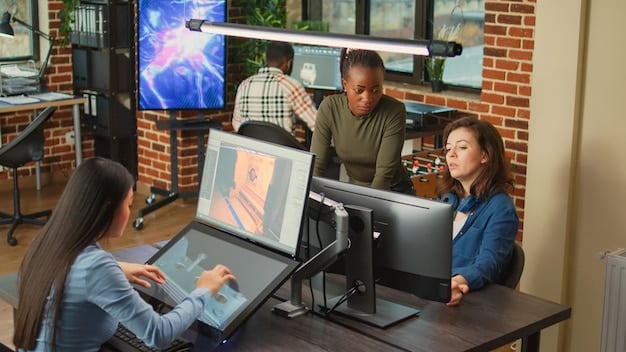Brazilian Documentary Funding: Reshaping Cinema 2025

New funding initiatives are poised to significantly reshape documentary filmmaking in Brazil over the next two years, influencing production, distribution, and thematic choices, and fostering greater diversity and accessibility within the industry.
The landscape of documentary filmmaking in Brazil stands at a pivotal juncture, teetering on the edge of potential transformation. With new funding initiatives on the horizon, the trajectory of this vibrant genre could shift dramatically, opening avenues for fresh narratives and diverse voices. This article delves into how these imminent changes might redefine Brazilian documentary cinema over the next two years.
The Current State of Brazilian Documentary Film
Brazilian documentary cinema has long been a powerful vehicle for social commentary, historical remembrance, and cultural expression. From the pioneering works of the “Cinema Novo” movement to contemporary productions exploring environmental issues, indigenous rights, and political landscapes, documentaries have mirrored Brazil’s complex reality. However, the sector has frequently contended with a volatile economic and political environment, directly impacting its funding and sustainability.
Traditionally, public funds, primarily through agencies like Ancine (Agência Nacional do Cinema) and various state cultural secretariats, have been the backbone of documentary production. While these sources have enabled numerous critically acclaimed films, their accessibility has often been hindered by bureaucratic complexities, political shifts, and intermittent budget cuts. This reliance on public funding has also meant that fluctuations in government policy can profoundly affect the entire industry, sometimes leading to periods of uncertainty and stagnation for filmmakers.
Challenges faced by filmmakers
- Access to consistent and predictable funding sources.
- Complex bureaucratic processes for grant applications.
- Limited private sector investment and sponsorship.
- Difficulties in achieving wide theatrical distribution for documentaries.
The distribution of Brazilian documentaries, especially internationally, has also presented significant challenges. While some films achieve festival success and limited releases abroad, many struggle to reach broader audiences, both domestically and globally. This underscores a critical need for
innovative distribution models and increased international partnerships, which new funding initiatives could potentially facilitate. The lack of robust infrastructure for independent distribution often forces filmmakers to rely on festival circuits or niche platforms, limiting their revenue streams and overall impact.
Piracy and the fragmented media consumption landscape further complicate the ecosystem. Despite these hurdles, Brazilian documentary makers have consistently demonstrated remarkable resilience and creativity, often producing compelling narratives against considerable odds. Their ability to tell stories that resonate deeply with local audiences while also speaking to universal human experiences is a testament to their dedication, highlighting the rich cultural tapestry of the nation and its enduring artistic spirit.
Overview of New and Proposed Funding Initiatives
The recent discussions and proposed legislation surrounding cultural funding in Brazil signal a potential turning point for documentary filmmaking. A notable shift appears to be towards more diversified and stable funding mechanisms, moving beyond exclusive reliance on direct governmental grants. These initiatives aim to attract private investment, streamline application processes, and foster long-term growth within the audiovisual sector, recognizing its economic and cultural importance.
Among the most promising developments are re-evaluated tax incentive programs and the potential establishment of new specialized funds dedicated exclusively to independent productions. These programs seek to incentivize corporations and individuals to invest directly in film projects, allowing them to deduct contributions from their taxes. The objective is to create a more robust and predictable financial pipeline, insulating the industry to some extent from political interference and fluctuating state budgets.
Key Initiatives and Their Potential Impact
- Revitalized Tax Incentive Laws: Designed to encourage corporate and individual investment by offering significant tax deductions for contributions to eligible film projects. This could unlock substantial private capital, reducing reliance on public funds.
- Specialized Audiovisual Funds: Creation of dedicated funds, possibly managed by independent bodies, specifically for documentary production, ensuring consistent support and specialized oversight.
- International Co-production Partnerships: Initiatives to foster collaborations with foreign production companies and broadcasters, attracting international capital and expertise, and broadening market access.
Beyond financial mechanisms, there’s growing emphasis on capacity building and professional development within the industry. Some proposals include grants for script development, post-production, and even market access for completed films. This holistic approach recognized that funding alone is not sufficient; a robust ecosystem also requires skilled labor, effective logistical support, and strategic market penetration. The aim is to create an environment where creative ideas can not only find financial backing but also the technical and professional support needed to flourish and reach global audiences, enhancing the overall quality and competitiveness of Brazilian documentaries.
Furthermore, discussions include the creation of investment funds managed by public-private partnerships, which could offer more flexible financing options than traditional grants. The goal is to establish mechanisms that are more resilient to economic downturns and political changes, providing a more stable environment for filmmakers to plan and execute long-term projects. This diversification of funding sources is seen as crucial for the sustainable growth and global competitiveness of Brazil’s documentary sector, reinforcing its position as a major player in the international film community and attracting more skilled professionals.
Impact on Production: Themes, Styles, and Scale
The influx of new funding, coupled with evolving support mechanisms, is expected to have a profound impact on the production aspects of Brazilian documentary filmmaking. One immediate effect could be an increase in the number of projects greenlit, providing opportunities for a wider range of emerging and established filmmakers. This expansion in volume is crucial for nurturing new talent and ensuring a continuous flow of diverse narratives, enriching the national cinematic landscape.
Thematically, more stable funding might empower filmmakers to tackle more ambitious and complex subjects, moving beyond immediate social critiques to explore speculative futures, historical reinterpretations, or even experimental artistic expressions. For example, some filmmakers might venture into documentaries that leverage cutting-edge technologies like virtual reality or augmented reality, pushing the boundaries of traditional storytelling. This financial stability could also encourage productions requiring extensive research, extended shooting periods, or access to sensitive archives, which are often cost-prohibitive under tighter budgets.
In terms of production styles, increased funding could lead to higher production values. This means better equipment, more experienced crews, and improved post-production resources, ultimately translating into visually richer and technically more sophisticated films. Filmmakers might be able to incorporate more complex cinematography, advanced sound design, and sophisticated editing techniques, enhancing the overall quality and global appeal of their work. This elevates standards across the board.
Potential shifts in documentary production
- Technological Advancement: Greater investment in modern equipment and innovative filmmaking techniques, including VR/AR.
- Enhanced Research and Development: More resources for in-depth pre-production, allowing for richer storytelling foundations.
- Diverse Storytelling: Encouragement of narratives from marginalized communities and lesser-known regions, fostering true inclusion.
The scale of productions could also expand significantly. Instead of relying on small, agile crews, some projects might be able to assemble larger teams, incorporate more extensive location shooting, and even venture into international locations for broader perspectives. This enhanced capacity allows for a deeper and more comprehensive exploration of subjects, contributing to the development of narratives that are both meticulously researched and visually compelling. The broader scope could also attract more international co-productions, bringing global perspectives and financial backing to Brazilian stories.
Moreover, the anticipated funding could stimulate production in regions beyond the traditional Rio-São Paulo axis, decentralizing the industry and nurturing local talent pools across Brazil. This geographical diversification is critical for truly capturing the vast cultural and social diversity of the country, moving beyond a concentrated, urban-centric narrative and fostering more authentic representations of various regional realities and voices, adding layers of authenticity to the storytelling process.

Impact on Distribution and Exhibition
New funding initiatives promise a significant overhaul of the distribution and exhibition landscape for Brazilian documentaries. Historically, securing widespread distribution, particularly beyond the festival circuit, has been a persistent hurdle for many films. The proposed changes aim to address this by incentivizing both domestic and international outreach, potentially through dedicated funds for marketing, festival participation, and secure digital platform partnerships.
A key area of impact will be the increased presence of Brazilian documentaries on global platforms. With more resources for translation, subtitling, and international marketing, films will be better positioned to gain exposure at major film festivals and secure distribution deals with international streamers and broadcasters. This enhanced global reach is critical not only for financial sustainability but also for promoting Brazilian culture and narratives on a worldwide stage.
Domestically, the initiatives could lead to more robust local exhibition strategies. This might include supporting independent cinemas, creating special screening programs in underserved communities, and developing educational outreach programs that use documentaries as tools for social engagement. The goal is to foster a stronger audience base within Brazil itself, ensuring that national stories resonate with their primary audience, fostering deeper engagement.
How distribution could evolve
- Enhanced Digital Presence: Investment in robust digital distribution platforms and strategies, making films globally accessible.
- Targeted Market Strategies: Funding for specialized marketing crucial for international film festivals and niche audiences.
- Community Engagement: Support for screenings in non-traditional venues to reach broader local audiences, beyond commercial cinemas.
Furthermore, the funding could facilitate the creation of an integrated ecosystem where production, distribution, and exhibition work hand-in-hand. For instance, some initiatives might tie funding directly to concrete distribution plans, ensuring that films are not just made but also seen. This integrated approach minimizes the risk of films being shelved or under-distributed, maximizing their cultural and economic impact. By ensuring a clear pathway from production to audience, these initiatives aim to create a more seamless and effective industry value chain.
Also, the emphasis on digital platforms and virtual cinemas, especially post-pandemic, could be amplified with new funding. This would allow films to bypass some of the traditional gatekeepers of theatrical distribution, reaching audiences directly through online channels, thereby expanding their viewership significantly. The flexibility offered by digital distribution also enables films to have longer exhibition lives, reaching audiences in cycles, instead of being limited by a traditional and often short theatrical run.
Foster New Voices and Diverse Narratives
Perhaps one of the most transformative potentials of the new funding initiatives lies in their capacity to actively foster new voices and promote diverse narratives within Brazilian documentary filmmaking. Historically, access to funding and production resources has often been concentrated in the hands of a few, leading to a degree of homogeneity in perspectives and thematic choices. The proposed changes aim to democratize this access, ensuring that a broader spectrum of society can tell their stories.
Initiatives are expected to include specific quotas or preferential treatment for projects led by or involving marginalized communities. This encompasses women, Afro-Brazilians, indigenous populations, LGBTQIA+ individuals, and filmmakers from economically disadvantaged regions. By actively seeking out and supporting these voices, the industry can unlock a wealth of untold stories, offering fresh insights and challenging existing perceptions, enriching the overall narrative landscape of Brazilian cinema.
Beyond direct funding for projects, there’s an increasing focus on capacity-building programs, workshops, and mentorship schemes specifically designed for underrepresented groups. These initiatives will provide not only financial support but also crucial training, networking opportunities, and professional guidance, equipping emerging filmmakers with the skills and confidence to navigate the complex world of film production and distribution.
Promoting inclusivity in film
- Targeted Grants: Dedicated funds for projects led by historically marginalized groups to ensure their stories are heard.
- Mentorship Programs: Connecting new filmmakers with experienced professionals for guidance and industry insights.
- Regional Production Hubs: Encouraging film production outside major cities, nurturing diverse regional cinematic expressions and local talent.
The emphasis on diversity extends to thematic content as well. While Brazil has a rich tradition of social justice documentaries, new funding could encourage stories that delve into lesser-explored facets of Brazilian culture, history, and contemporary life. This might include films about scientific advancements, culinary traditions, fashion, or even personal memoirs that offer unique, intimate perspectives. The idea is to broaden the genre’s scope beyond traditional socio-political themes.
Ultimately, by actively investing in new voices and diverse narratives, Brazil’s documentary industry can achieve greater authenticity and relevance. These stories, born from varied experiences and worldviews, will not only resonate more deeply with local audiences but also present a richer, more nuanced image of Brazil to the international community, challenging stereotypes and promoting a more accurate understanding of its multifaceted identity.
Challenges and Potential Pitfalls
While the prospect of new funding initiatives for Brazilian documentary filmmaking is largely positive, it is imperative to acknowledge the potential challenges and pitfalls that lie ahead. The effective implementation of these programs will be crucial, as even well-intentioned policies can struggle if not managed transparently and efficiently. Bureaucracy, a perennial issue in Brazil, could hamper the timely disbursement of funds and create barriers to access for smaller independent producers, undermining the very goal of democratizing the industry.
Furthermore, the political climate remains a significant variable. Funding for cultural projects in Brazil has often been subject to political whims and budgetary cuts, leading to instability. Even with new frameworks, there’s no guarantee that future administrations will maintain the same level of commitment or financial support. This underscores the need for durable, institutionalized mechanisms that transcend short-term political cycles, providing long-term predictability essential for sustainable growth and stability. Industry stakeholders must advocate for policies that are resilient to political shifts.
Potential obstacles to success
- Bureaucratic Inefficiencies: Delays and complex processes in fund disbursement and application reviews.
- Political Instability: Risk of funding cuts or policy changes with shifts in government administrations.
- Market Dependence: Over-reliance on a few distribution platforms, potentially limiting reach and bargaining power for filmmakers.
Another concern is ensuring equitable distribution of resources. There’s a risk that larger, more established production companies might disproportionately benefit from new initiatives, leaving emerging or independent filmmakers struggling to compete. Designing mechanisms that actively prioritize smaller projects and diverse voices, perhaps through specific earmarks or simplified application processes for certain categories, will be vital to prevent the concentration of power and resources within a few hands.
The sustainability of private funding models also needs careful consideration. While tax incentives are attractive, their long-term effectiveness depends on the economic health of the country and the continued willingness of corporations to invest in cultural projects. A diversified funding portfolio that balances public, private, and international sources is essential for building a truly resilient industry. Over-reliance on any single source could expose the sector to undue risks, making careful planning critical for long-term viability.

Looking Ahead: The Next Two Years
The next two years represent a critical period for Brazilian documentary filmmaking, poised to either consolidate the promise of new funding initiatives or reveal their limitations. While the challenges are real, the momentum building around these changes suggests a potentially transformative era. The immediate focus will be on the effective implementation of these programs, ensuring smooth processes and broad accessibility for filmmakers across the country, vital for success.
We anticipate a visible increase in the volume of documentary productions during this period, alongside a diversification of themes and styles. Filmmakers will likely embrace more ambitious projects, venturing into innovative storytelling techniques and exploring a wider array of subjects. This will lead to a richer cinematic tapestry, reflecting Brazil’s multifaceted identity and cultural wealth, attracting more audiences locally and globally.
Success will depend not only on the availability of funds but also on the industry’s ability to adapt, innovate, and forge new partnerships. Collaboration between public and private sectors, academic institutions, and international bodies will be paramount. Building a resilient infrastructure for production, distribution, and exhibition is key to sustaining the growth initiated by these new funding models, ensuring long-term success.
Key developments to watch
- Launch of New Funds: Monitoring the rollout and early impact of newly established funding mechanisms.
- Emergence of New Talent: Observing how diverse voices and regions benefit from increased access to resources.
- International Market Penetration: Tracking the success of Brazilian documentaries in global festivals and distribution platforms, indicating broader reach.
Moreover, the emphasis on digital distribution platforms will be particularly important in expanding the reach of Brazilian documentaries, allowing them to circumvent traditional gatekeepers and connect directly with global audiences. This shift could democratize access to content, making it easier for niche or regionally focused films to find their audience. The industry’s agility in leveraging these platforms will dictate how widely Brazilian stories are seen.
Ultimately, the next two years will serve as a litmus test for the long-term viability and impact of these initiatives. If successful, they have the potential to not only invigorate Brazilian documentary filmmaking but also to solidify its position as a significant global player, consistently producing high-quality, impactful, and culturally rich cinematic works that resonate far beyond its borders, cementing its international reputation and influence.
| Key Point | Brief Description |
|---|---|
| 🎬 Funding Diversification | Shift from solely public grants to include private investment and international co-productions. |
| 🌈 Diverse Narratives | Increased support for filmmakers from marginalized communities and varied regional stories. |
| 🌍 Global Reach | Enhanced distribution and marketing efforts for international audiences and festivals. |
| ⚙️ Production Quality | Higher production values through better equipment, skilled crews, and advanced post-production. |
Frequently Asked Questions About Brazilian Documentary Filmmaking
▼
The primary goals are to diversify funding sources beyond public grants, attract private investment through tax incentives, promote a wider range of narratives and voices, and enhance the global presence of Brazilian documentaries. These initiatives aim to create a more stable and robust ecosystem for filmmakers, fostering sustainable growth.
▼
With more stable funding, filmmakers can undertake more ambitious and diverse projects, exploring complex themes beyond traditional social commentary. There will be an emphasis on supporting emerging voices, particularly from marginalized communities, leading to richer, more authentic stories that represent Brazil’s vast cultural landscape. This encourages innovation both in content and style.
▼
Challenges include the potential for bureaucratic inefficiencies in fund disbursement, continued political instability affecting cultural policies, and fierce competition for resources. Ensuring equitable distribution of funds to smaller, independent productions and managing the sustainability of private sector investment remain key concerns for the industry’s health and growth.
▼
New funding is expected to improve international exposure through dedicated budgets for marketing, subtitling, and participation in major film festivals. It will also foster partnerships with global streamers and distributors, broadening the reach of Brazilian films and promoting the country’s culture on a worldwide stage, enhancing their market presence.
▼
Increased funding may facilitate investment in advanced production equipment and innovative formats like virtual reality (VR) and augmented reality (AR) within documentaries. It will also bolster digital distribution strategies, allowing films to bypass traditional exhibition hurdles and reach wider audiences directly through online platforms, leveraging technology for broader impact and accessibility.
Conclusion
The trajectory of documentary filmmaking in Brazil is undeniably at a pivotal moment. The proposed and emerging funding initiatives hold substantial promise for reshaping the genre within the next two years, moving towards a more diversified, resilient, and inclusive industry. While hurdles certainly remain, the clear intention to foster new voices, elevate production quality, and expand global reach underpins a hopeful future. The effectiveness of these changes will hinge on transparent implementation and sustained commitment, allowing Brazilian storytellers to continue capturing and reflecting the nation’s profound complexities on a grander, more globally visible scale.





